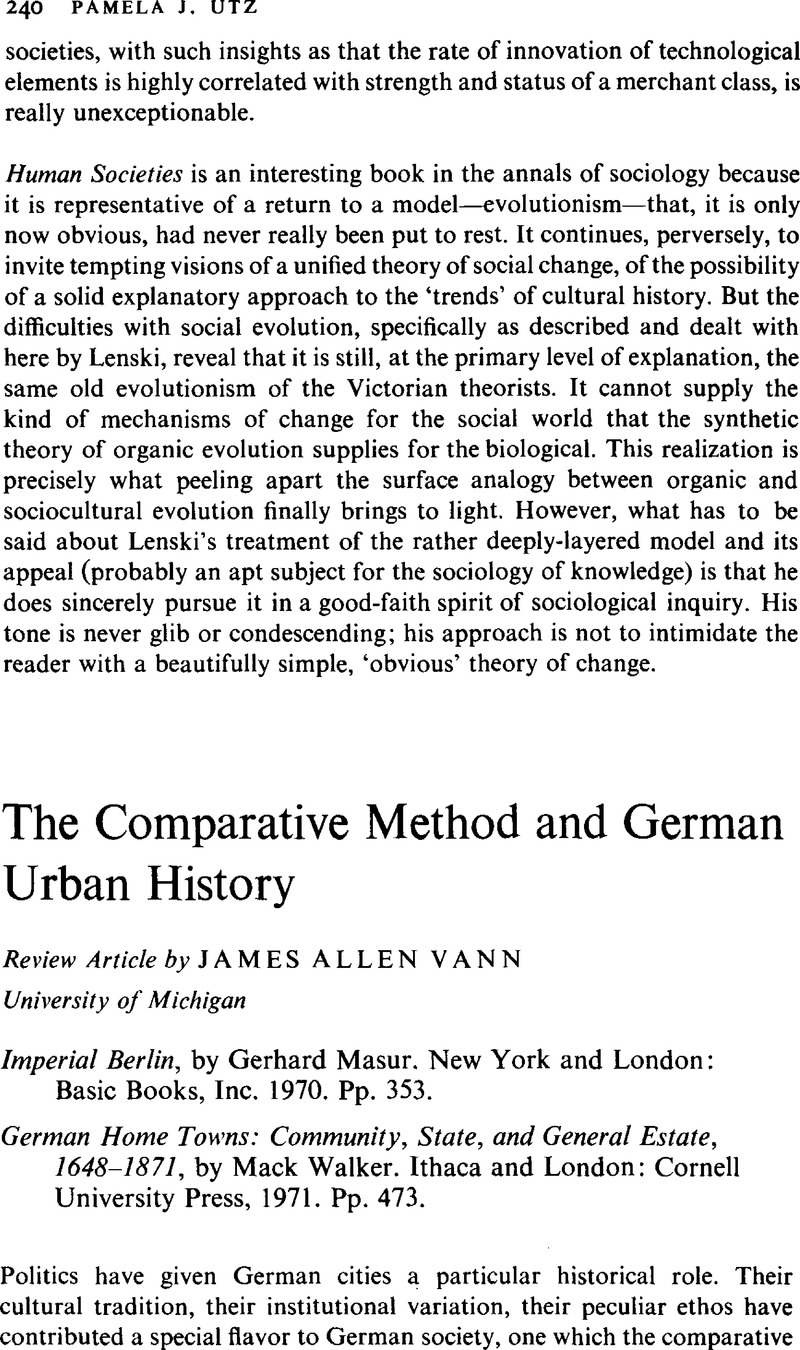No CrossRef data available.
Article contents
The Comparative Method and German Urban History
Published online by Cambridge University Press: 03 June 2009
Abstract

- Type
- Review Articles
- Information
- Copyright
- Copyright © Society for the Comparative Study of Society and History 1973
References
1 See Swanson, Guy's Religion and Regime: a Sociological Account of the Reformation (Ann Arbor, 1962) for a provocative sociological attempt at German urban comparison.Google Scholar
2 Warner, Sam Bass, Streetcar Suburbs: the Process of Growth h. Boston, 1870–1900 (Cambridge, 1962) and The Private City: Philadelphia in Three Periods of its Growth (Philadelphia, 1968).Google ScholarLockridge, K. A., A New England Town: The First Hundred Years, Dedham, Massachusetts, 1636–1736 (New York, 1970).Google Scholar
3 Ford, F. L., Strasbourg in Transition, 1648–1789 (Cambridge, 1958).Google ScholarSchorske, C. E., ‘Politics and the Psyche in fin de Siecle Vienna: Schnitzler and Hofmannsthal,’ American Historical Review, 64 (1961);Google Scholar‘Politics in a New Key: an Austrian Triptych,’ Journal of Modern History, 39 (1967);Google Scholar and ‘The Transformation of the Garden: Ideal and Society in Austrian Literature,’ American Historical Review, 73 (1967).Google Scholar
4 Voelcker, H., Die Stadt Coethes: Frankfurt am Main im XVlll Jahrhundert (Frankfurt am Main, 1932).Google ScholarSchramm, P. E., Neun Cenerationen. Dreihundert Jahre deutsche Kulturgeschichte im Licht der Schicksale einer Hamburger Bürgerfamilie, 1648–1948 (Göttingen, 1963).Google ScholarBraubach, M., Kurköln: Gestalten und Ereignisse aus zwei Jahrhunderten rheinischer Geschichte (Münster, 1949).Google ScholarDreyfus, F. G., Mayence: Sociétés et Mentalités à Mayence dans la seconde moitie du XVIII siècle (Paris, 1968).Google Scholar See also Strauss, G., Nuremberg in the Sixteenth Century (New York, 1968).Google Scholar
5 Zweig, Stefan, The World of Yesterday (New York, 1943).Google Scholar
6 One of the most interesting aspects of Walker's study is that it helps rescue German history from the kind of argument advanced in Krieger's, LeonardThe German Idea of Freedom (Boston, 1957), where the German bureaucracy becomes the ‘substitute middle class’ and where liberal ideas are seen as emanating from authoritarian, not popular, sources. Walker writes not about the liberal bourgeoisie that Germany did not get but about the hometown Bürgerschaft that Germany preeminently did get. And in the process he shows that they had a vital political tradition that was by no means always authoritarian.Google Scholar
7 Otto, Brunner, Adeliges Landleben und europäischer Geist (Salzburg, 1949)Google Scholar and Land und Herrschaft (Brünn, 1943).Google Scholar
8 For an analysis of the political role of the Reichstädte in the provincial assemblies, see Vann, J. A., ‘Parliamentary Politics and Feudal Privilege: the Swabian Kreis, 1664–1715’ (unpublished Ph.D. dissertation, Harvard University, 1970);Google ScholarWines, R., ‘Imperial Circles: Princely Diplomacy and Imperial Reform, 1681–1714,’ Journal of Modern History, 39 (03, 1967), pp. 1–29;CrossRefGoogle Scholar and Süss, G. A., ‘Geschichte des oberrheinischen Kreises und der Kreisassociation, 1697–1714,’ Zeitschrift für die Geschichte des Oberrheins, 53 (1955), pp. 317–425; 54 (1956), pp. 10–224.Google Scholar
9 The best analysis of a territorial assembly is Grube's, W.Stuttgarter Landtag, 1457–1957 (Stuttgart, 1957).Google Scholar See also Lichtner, A., Landesherr und Stände in Hessen-Cassel (Göttingen, 1913)Google Scholar and Thiimmler, C., Zur Geschichte des sächsischen Landtags (Leipzig-Rendnitz, 1896).Google Scholar A helpful English study is Carsten, F. L., Princes and Parliaments (Oxford, 1959).Google Scholar
10 The most thorough discussion of territorial financial structure is found in Dollinger, H., Studien zur Finanzreform Maximilians I. von Bayern (Göttingen, 1968).Google Scholar Though these reforms were carried out in the early seventeenth century, they set the tone for the fiscal policies that were adopted subsequently by the other territorial states. A case study on a later period is Croon's, H., ‘Stände und Steuern in Julich-Berg im 17. und vornemlich 18. Jahrhundert.’ Rheinisches Archiv, X (Bonn, 1929).Google ScholarBruford, W. H., Germany in the Eighteenth Century (Cambridge, 1935) argues that by the end of the eighteenth century Heidelberg had only 11,000 inhabitants and Hanover 15,500. Are these home towns ? Certainly cities of such crucial territorial importance played a vital role in the state fisc. Similarly, what about Würzburg. Tübingen, Bamberg? These cities also fall into Walker's limit.Google Scholar
11 Seventeenth-century perceptions of change are discussed in Wunder's, B. ‘Die Sozial-struktur der Geheimratskollegien in den süddeutschen protestantischen Fürstentümern (1660–1750),’ Vierteljahrschrift für Sozial-und Wirtschaftsgeschichte, 58 (1971). Letters from Swabian urban officials and hometown Burghermasters are found in Staatsarchiv Stuttgart, Schwabische Kreisakten. These hometowners discuss frankly their sense of dramatic change and their keen interest and involvement in regional affairs.Google Scholar
12 See Riehl, W. H., Land und Leute (2nd. ed.; Stuttgart, 1855), pp. 132–5, 139–41, 159–217.Google Scholar


